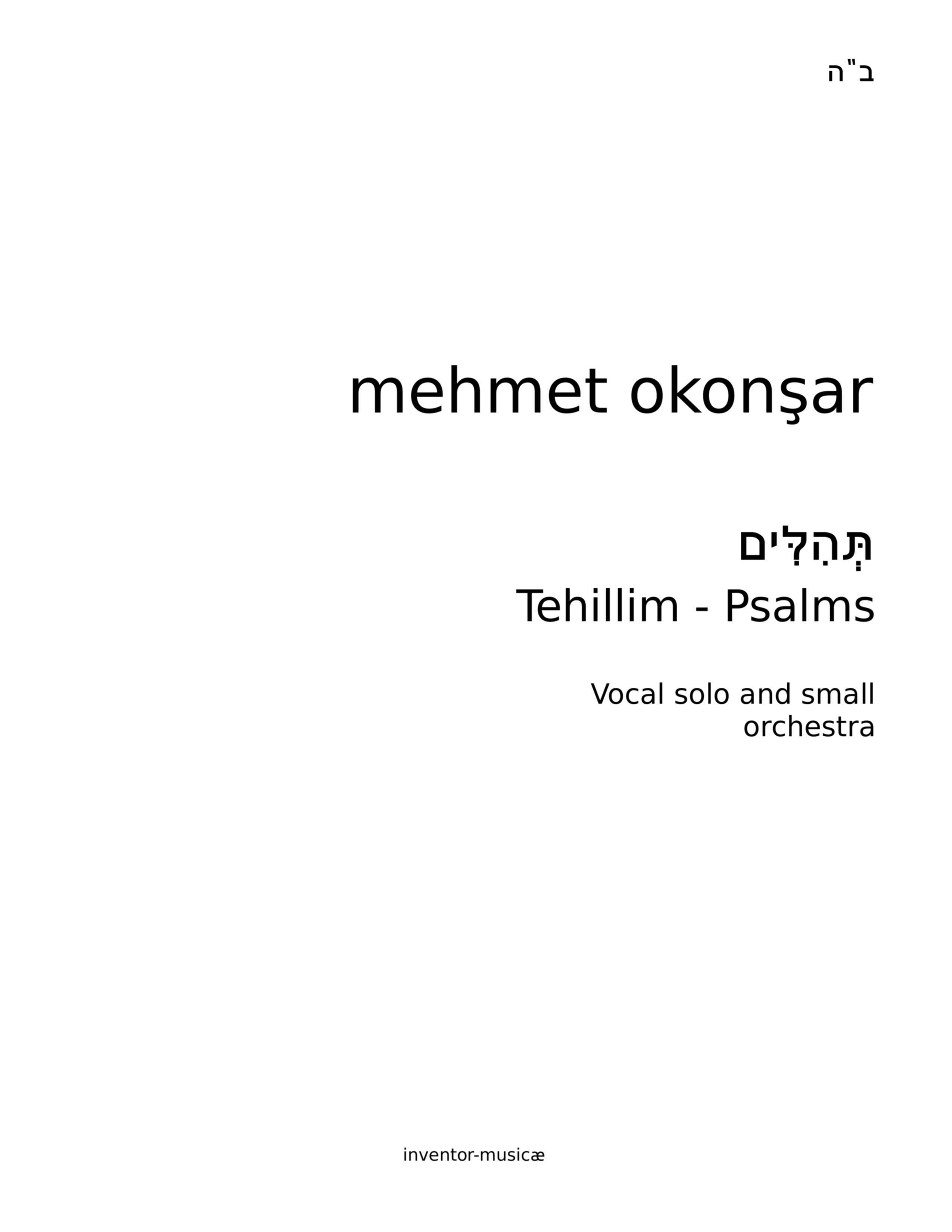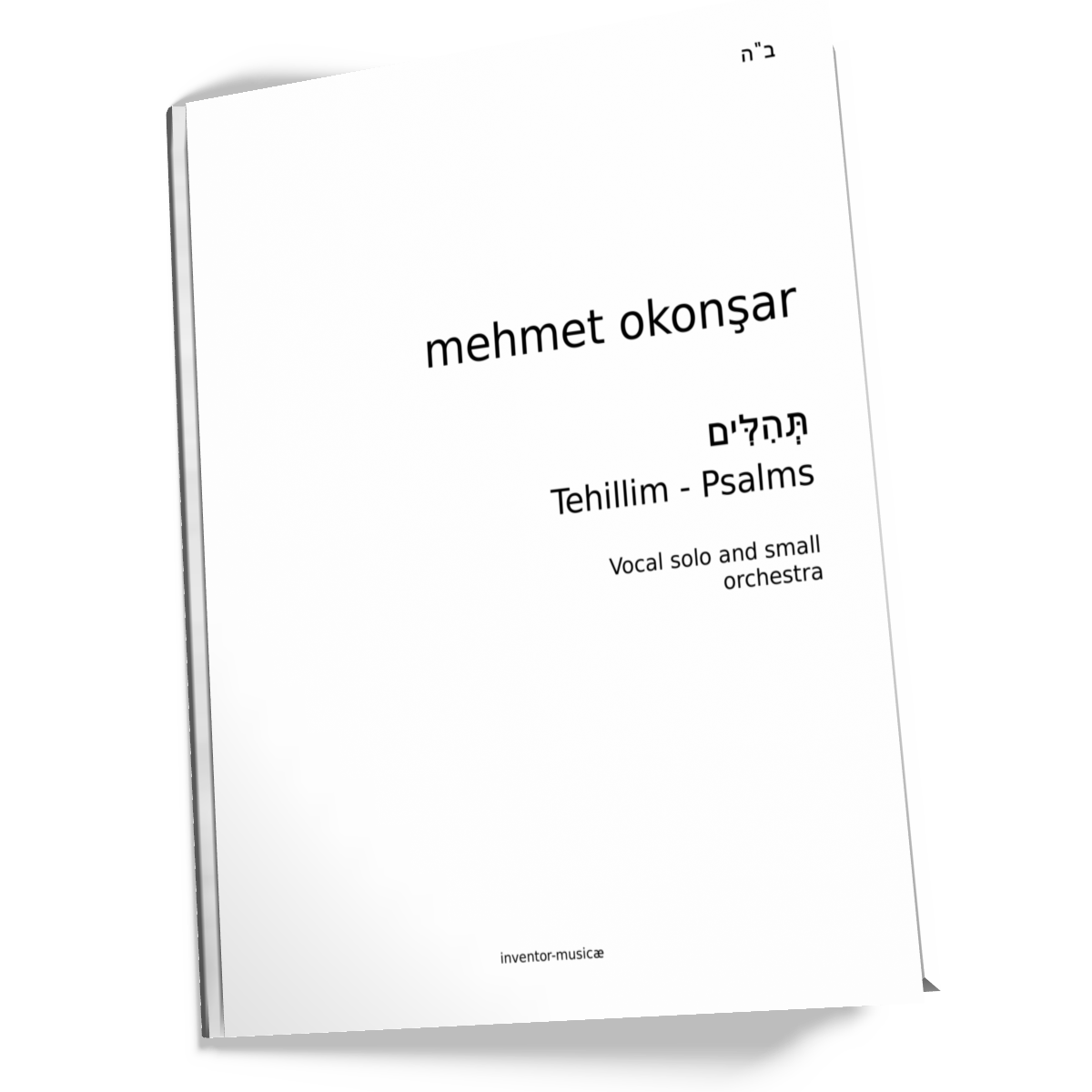
Tehillim - Psalms
Six pieces for vocal solo and chamber orchestra
Dedicated to Ms. France Fenton


|
According to Stephen L. Harris ("Understanding the Bible", 1985), all together, the 150 poems which constitute the Psalms, express virtually the full range of Israel's religious faith. In addition to the title of the collection, which translates as "song" or "hymns" from both Hebrew and Greek, superscriptions (or headings) in many of the Psalms provide musical references and some direction, even references to melodies that, anciently, would have been well-known; however, no musical notation has survived. Jewish tradition, recorded in the Talmud (Talmud, Bava Basra 15a), posits that the Psalms are the work of David (seventy-three Psalms are with David's name), based on the writings of ten ancient psalmists (including Adam and Moses). Psalms were set to music by many composers.1 They have often been set as part of a larger work. They also appear in Vespers, including those by Claudio Monteverdi, Antonio Vivaldi, and Wolfgang Amadeus Mozart, who wrote such settings as part of their responsibilities as church musicians. Some Psalms are inserted in Requiem compositions, such as Psalm 126 in A German Requiem of Johannes Brahms and Psalms 130 and 23 in John Rutter's Requiem. Other examples of Psalms in music are by by Orlande de Lassus (1584); Le Roi David by Arthur Honegger (1921); Symphony of Psalms by Igor Stravinsky (1930); Chichester Psalms by Leonard Bernstein (1965); Tehillim by Steve Reich (1981). For this composition I have selected the following Psalms chapters (i.e. numbers): 6: “.., [2]: O LORD, rebuke me not in Thine anger, neither chasten me in Thy wrath.” 61: “.., [2]: Hear my cry, O God; attend unto my prayer.” 150: “Hallelujah. Praise God in His sanctuary;” 130: “.. Out of the depths have I called Thee, O LORD.” 1: “Happy is the man that hath not walked in the counsel of the wicked,” 122: “.., I rejoiced when they said unto me: 'Let us go unto the house of the LORD.” Musical settings: The musical scale of twelve notes can be subdivided into six (reversible) intervals. They go from half-tone to tritone. Namely: the (chromatic) half-tone, whole-tone, minor third, major third, perfect fourth and the tritone. All other intervals are inversions of those six. With each interval, except the chromatic (piece N.1) and the perfect fourth (piece N.6) which expand to the entire twelve note-range, there is a limited number of notes available. The tritone (6 semitones: C to F-sharp) makes for only two notes; the whole-tone gives the pentatonic (5 notes) scale (C - D - E - F-sharp - G-sharp - A-sharp); the minor third results to four notes: C - E-flat - F-sharp - A; the major third: C - E - G-sharp, three notes. By using exclusively the scales resultant of each of these intervals, the music acquires on both horizontal (melodic) and vertical (harmonic) levels a typical "sound-color". The relations between intervals (and scales) and the movements: The correlation of the pieces, the intervals and the resulting notes is as follows: Piece N.1, Psalm Chapter 6: “O LORD, rebuke me not in Thine anger, neither chasten me in Thy wrath.”, interval of semitone, all pitches employed; Piece N.2, Psalm Chapter 61: “Hear my cry, O God; attend unto my prayer.”, interval of tritone, only two pitches: C and F-sharp; Piece N.3, Psalm Chapter 150: “Hallelujah. Praise God in His sanctuary;”, interval of major third, only three pitches: D - F-sharp - B-flat; Piece N.4, Psalm Chapter 130: “Out of the depths have I called Thee, O LORD.”, interval of minor third, only four pitches: D - F - A-flat - B; Piece N.5, Psalm Chapter 1: “Happy is the man that hath not walked in the counsel of the wicked,” interval of major second, pentatonic scale, five pitches: C - D - E - F-sharp - G-sharp - A-sharp; Piece N.6, Psalm Chapter 122: “I rejoiced when they said unto me: Let us go unto the house of the LORD.”, interval of perfect fourth, all twelve pitches. Words, lyrics and prosody: The vocal part is not aimed towards the straightforward understanding of the lyrics by the listener. Traditional prosody rules are not observed. Words, phrases, concepts and principally emotions are deepened with the use of music and the vocal part, even though singing with words, is elaborated as any other instrument. It is best to read and get acquinted with the words before listening to the music.
|
|||||||||
|
|||||||||
|
|||||||||
|



